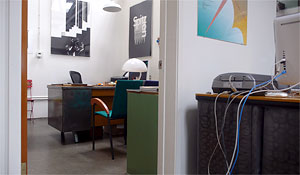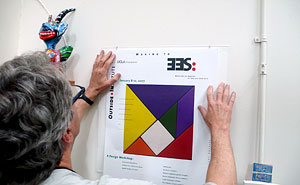About
William Longhauser received a BFA degree in graphic design from the College of Design, Art, and Architecture at the University of Cincinnati, and an MFA in design from Indiana University. He has also completed two years of post-graduate study at the School of Design, in Basel, Switzerland. Before moving to Los Angeles in June, 2000, he was a tenured professor at the University of the Arts, Philadelphia, where he taught in the graphic design department since 1977 and was chairman of the department for three years.
In addition to his activities related to graphic design education, he is president of Longhauser Design, a design firm offering comprehensive visual communications services to a wide range of clients, from corporations and nonprofit organizations to educational and cultural institutions.
Longhauser’s design work has consistently received awards and has been featured in international publications and exhibitions. Six of his works were included in “Typographism,” an international exhibition of graphic design at the Georges Pompidou National Contemporary Art Center in Paris. His posters have been exhibited in international poster biennales held in Helsinki and Lahti, Finland; Warsaw, Poland; and Brno, Czechoslovakia. His work was in “Design USA,” a major design exhibition travelling to nine cities in the Soviet Union. As one of seventeen graphic designers invited to represent contemporary graphic design in America, his posters were included in the exhibition, “Contemporary U.S.A. and U.S.S.R. Poster Exhibition,” shown in Ohgaki, Osaka, and Tokyo, Japan. Longhauser’s work was included in a major exhibition organized by Cooper–Hewitt, National Design Museum in New York called “Mixing Messages: Graphic Design in Contemporary Culture,” September–December 1996. In October, 2001, he was invited to exhibit his work in the exhibition “TypoJanchi: Seoul Typography Biennale”, in Seoul, Korea.
His work has been published in Graphis Posters, Graphis Annual, Communications Arts magazine, Idea magazine, The Annual of the American Institute of Graphic Arts, and Print’s Design Annual. His posters are in the permanent collection of the Newark Museum of Art, The Cooper Hewitt Museum, New York, and the Musee D’Histoire Contemporaine, Paris.
Longhauser’s work is featured in the following graphic design books: Graphic Style from Victorian to Post-Modernism traces the history of graphic design; Type and Image: The Language of Graphic Design, explores the essence of graphic design in our time as a potent means of communication and a major component of our visual culture; The 20th-Century Poster: Design of the Avant-Garde, an anthology of avant-garde poster design from the turn of the century to the present; The History of Graphic Design, text and supporting visual documentation of the history of graphic design; Designer’s Guide To Typography, views and work from leading designers in the field representing the contemporary world of typography; and currently in production, No More Rules by Rik Poyner which will analyze the radical developments and ideas that have revolutionized the world of graphic design during the past few decades.
Longhauser has lectured on graphic design education and visual communication both in the United States and abroad and is one of the founders of the first chapter of the American Institute of Graphic Arts in Philadelphia. He is currently writing a book “Not by Design”, exploring the influence of technology on culture and its impact on design and design education.
His poster designed for an exhibition of works by architect Michael Graves accompanies an article for Encyclopedia Britannica entitled “History of Graphic Design” written by graphic design historian, Professor Philip Meggs. In addition to the print version, it will appear online at www.britannica.com.
In 2006, he founded the Outside Institute, an educational organization that functions as a working laboratory for creative experimentation through the direct experience of making. The institute conducts week long workshops that use fundamental design principles, invention, and imagination to search for new ways of seeing by discovering intersections between design, art, architecture, music, dance, science, philosophy, and language.


